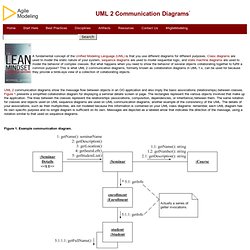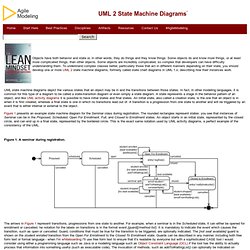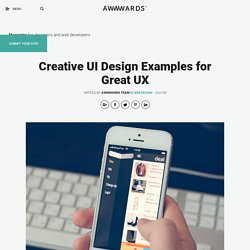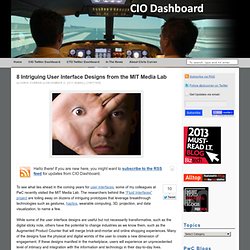Systems Analysis Course
> Tcaruso2
> Financial Manager
> Teacher
Abstract factory pattern. Introduction to UML 2 Communication Diagrams. UML 2 communication diagrams show the message flow between objects in an OO application and also imply the basic associations (relationships) between classes.

Figure 1 presents a simplified collaboration diagram for displaying a seminar details screen or page. The rectangles represent the various objects involved that make up the application. The lines between the classes represent the relationships (associations, composition, dependencies, or inheritance) between them.
Introduction to UML 2 State Machine Diagrams. UML state machine diagrams depict the various states that an object may be in and the transitions between those states.

In fact, in other modeling languages, it is common for this type of a diagram to be called a state-transition diagram or even simply a state diagram. A state represents a stage in the behavior pattern of an object, and like UML activity diagrams it is possible to have initial states and final states. An initial state, also called a creation state, is the one that an object is in when it is first created, whereas a final state is one in which no transitions lead out of. A transition is a progression from one state to another and will be triggered by an event that is either internal or external to the object. Figure 1 presents an example state machine diagram for the Seminar class during registration.
Figure 1.
UML state machine. UML state machine,[1] also known as UML statechart, is a significantly enhanced realization of the mathematical concept of a finite automaton in computer science applications as expressed in the Unified Modeling Language (UML) notation.

The concepts behind it are about organizing the way a device, computer program, or other (often technical) process works such that an entity or each of its sub-entities is always in exactly one of a number of possible states and where there are well-defined conditional transitions between these states. UML state machine is an object-based variant of Harel statechart,[2] adapted and extended by UML. The goal of UML state machines is to overcome the main limitations of traditional finite-state machines while retaining their main benefits. UML statecharts introduce the new concepts of hierarchically nested states and orthogonal regions, while extending the notion of actions.
Basic state machine concepts[edit]
The EHR Non-User Interface. Every time someone publishes an article or a paper or a blog post that has anything remotely to do with Electronic Health Records (EHR), there is usually a flurry of reactions in the comments section, now available in most publications, and these always include at least half a dozen anonymous statements, usually from clinicians, decrying the current state of EHR software, best summed up by a commenter on THCB: “It is the user interface stupid!...

It has to be designed from the ground up to be an integral part of the patient care experience”. Can’t argue with that now, can you? Particularly when coming from a practicing physician.
Creative UI Design Examples for Great UX. UX (User Experience) is all those elements and factors related to the user's interaction with a particular environment or device which generate a positive or negative perception of the product, brand or device.

UX is subjective and focused on use. The standard definition of UX is "a person's perceptions and responses that result from the use or anticipated use of a product, system or service". These factors are related to design and usability, but also to the emotions and feelings generated in the user, accessibility, brand trust... In the case of the web, the user's experience with the device is not a matter of concern to web designers: big hardware companies do the job of building our machines and computers.
The Future of User Interfaces. User interfaces—the way we interact with our technologies—have evolved a lot over the years.

From the original punch cards and printouts to monitors, mouses, and keyboards, all the way to the track pad, voice recognition, and interfaces designed to make it easier for the disabled to use computers, interfaces have progressed rapidly within the last few decades. But there’s still a long way to go and there are many possible directions that future interface designs could take. We’re already seeing some start to crop up and its exciting to think about how they’ll change our lives.
8 Intriguing User Interface Designs from the MIT Media Lab. To see what lies ahead in the coming years for user interfaces, some of my colleagues at PwC recently visited the MIT Media Lab.

The researchers behind the “Fluid Interfaces” project are toiling away on dozens of intriguing prototypes that leverage breakthrough technologies such as gestures, haptics, wearable computing, 3D, projection, and data visualization, to name a few. While some of the user interface designs are useful but not necessarily transformative, such as the digital sticky note, others have the potential to change industries as we know them, such as the Augmented Product Counter that will merge brick-and-mortar and online shopping experiences. Many of the designs fuse the physical and digital worlds of the user to create a new dimension of engagement. If these designs manifest in the marketplace, users will experience an unprecedented level of intimacy and integration with the information and technology in their day-to-day lives.
GUI widget. Gtk3-demo, a program to demonstrate the GUI widgets in GTK+ version 3.

Various widgets History and use[edit] In the context of an application, a widget may be enabled or disabled at a given point in time. An enabled widget has the capacity to respond to events, such as keystrokes or mouse actions. A widget that cannot respond to such events is considered disabled. A related (but different) concept is the desktop widget, a small specialized GUI application that provides some visual information and/or easy access to frequently used functions such as clocks, calendars, news aggregators, calculators and desktop notes.
Etymology[edit]
StarUML 5.0 User Guide. StarUML 5.0 User Guide Copyright © 2005 Minkyu Lee.

Copyright © 2005 Hyunsoo Kim. Copyright © 2005 Jeongil Kim. Copyright © 2005 Jangwoo Lee. Copyright © 2005 Deukkyu Gum.
Alistair.cockburn. List of Unified Modeling Language tools. From Wikipedia, the free encyclopedia Jump to navigationJump to search Wikimedia list article This article compares UML tools.

UML tools are software applications which support some functions of the Unified Modeling Language. General[edit] Features[edit] References[edit] External links[edit] UML Tools at Curlie.
UML Activity Diagrams Examples. Here we provide several examples of UML activity diagrams: Online shopping UML activity diagram Purpose: An example of activity diagram for online shopping. Summary: Online customer can browse or search items, view specific item, add it to shopping cart, view and update shopping cart, do checkout.
UML Class Diagrams Examples - Abstract Factory Design Pattern, Library Management, Online Shopping, Hospital, Digital Imaging in Medicine, Android.
Here we provide some examples of class diagrams and object diagrams: Abstract Factory Design Pattern Purpose: Illustrate Abstract Factory design pattern. Summary: Abstract Factory is creational software design pattern. This pattern provides interfaces for creating families of related or dependent objects without specifying their concrete classes. Library domain model. Class diagram. Hierarchy of UML 2.0 Diagrams, shown as a class diagram. The individual classes are represented just with one compartment, but they often contain up to three compartments.
Introduction[edit] The class diagram is the main building block of object oriented modelling.
StarUML - The Open Source UML/MDA Platform. Class (computer programming)
In some languages, classes are only a compile-time feature (new classes cannot be declared at runtime), while in other languages classes are first-class citizens, and are generally themselves objects (typically of type Class or similar).
ATG Book of the Week: Information from Processes: About the Nature of Information Creation, Use, and Representation. Scrum (development)
Agile Unified Process. Agile Unified Process (AUP) is a simplified version of the IBM Rational Unified Process (RUP) developed by Scott Ambler.[1] It describes a simple, easy to understand approach to developing business application software using agile techniques and concepts yet still remaining true to the RUP.
The AUP applies agile techniques including test driven development (TDD), Agile Modeling, agile change management, and database refactoring to improve productivity.
Extreme programming. Planning and feedback loops in extreme programming.
Agile software development. Agile software development describes a set of values and principles for software development under which requirements and solutions evolve through the collaborative effort of self-organizing cross-functional teams.[1] It advocates adaptive planning, evolutionary development, early delivery, and continuous improvement, and it encourages rapid and flexible response to change.[2] These principles support the definition and continuing evolution of many software development methods.[3] History[edit]
Agile software development. Agile software development is a set of principles for software development in which requirements and solutions evolve through collaboration between self-organizing,[1] cross-functional teams.
Software design pattern. Communication diagram. Communication diagrams. State diagram. State diagrams. Introduction to UML 2 Sequence Diagrams. Sequence diagrams are typically used to model: Usage scenarios.
Sequence diagram examples. Class Diagram Examples. Class diagram. Sequence diagram. Activity diagram. Activity Diagrams. Semi-structured interview. Systems Analysis Terms.










